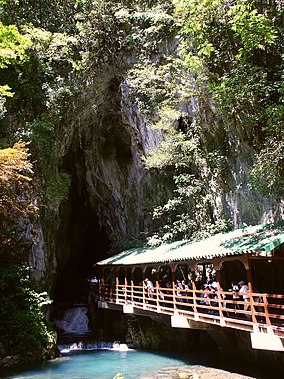| Akiyoshidai Quasi-National Park | |
|---|---|
| 秋吉台国定公園 | |
IUCN category V (protected landscape/seascape) | |
 Akiyoshidō cave | |
| Location | Yamaguchi prefecture, Japan |
| Nearest city | Mine |
| Coordinates | 34°13′55″N 131°18′10″E / 34.2320°N 131.3027°E [1] |
| Area | 45.02 square kilometres (17 sq mi) |
| Established | November 1, 1955 |
| Governing body | Yamaguchi Prefecture, Japan [2] |
Akiyoshidai Kokutei Kōen (秋吉台国定公園) is a Quasi-National Park in Yamaguchi Prefecture, Japan. [3] [4] It was founded on 1 November 1955 and has an area of 45.02 km². [5]
It includes part of the Akiyoshi plateau (秋吉台, Akiyoshidai), a 130 square kilometre area of karst topography, as well as over 400 limestone caves. The area is rated a protected landscape (category V) according to the IUCN. [6] Like all Quasi-National Parks in Japan, the park is managed by the local prefectural government. [2]
The Akiyoshidai Groundwater System is a Ramsar Site and wetland of international importance. [7]
Facilities
Akiyoshidai Quasi-National Park is served by a natural history museum, visitor centre, rest house, youth hostel and park headquarters building, and is traversed by a scenic roadway and several walking trails. Events include a fireworks festival in July, a “Karst Walk” in November, and an annual burning off of dry grasses in February called “Yamayaki”.
Geology
The plateau consists of uplifted reef limestones of Paleozoic age, which were thickened by overfolding during the Akiyoshidai orogenic movement. Subsequent erosion has created an undulating karst landscape dimpled with many dolines and countless limestone pinnacles up to two meters in height. Beneath the surface lie hundreds of caves, a few of them quite significant geologically. Numerous fossils of Pleistocene age have been found in these caves, including those of the Japanese rhinoceros, Stegodont elephant, Naumann elephant, Young tiger, and many other animals from the last interglacial period.
The area around Akiyoshidai was heavily forested about 500,000 years ago. In the Jōmon period, with the general area serving as a hunting ground and the bottoms of sinkholes as vegetable fields. Numerous Paleolithic artifacts have been recovered. As farming started in Japan the local people eventually entirely replaced the forested landscape with Japanese pampas grass for feeding their animals and thatching houses. Repeated cycles of burning the grass have kept trees from growing back since.
Akiyoshidō
Towards the southern end of Akiyoshidai is the Akiyoshidō cave, named by Emperor Hirohito on May 30, 1926, when he was still crown prince. This spacious cave is up to 100 meters wide and has 8.79 kilometers of passages, making it one of the longest in Japan after Akkadō cave, and one of the longest in Asia. At the present time an about one-kilometer-long section of the cave is open to the public as a sightseeing course, with a walkway and bridge system, entering at the cave's lowest point and exiting via an artificial elevator. This portion of the cave is also well decorated with a variety of large and colorful speleothems.
Gallery
-
Stalactite called "Gold Column"
-
View of Karst landscape
-
Inside Akiyoshidō caves
-
View of Karst topography
See also
References
- ^ "Akiyoshidai Quasi-National Park Map". Archived from the original on 2011-06-14. Retrieved 2011-09-17.
- ^ a b "National Park systems: Definition of National Parks". National Parks of Japan. Ministry of the Environment of the Government of Japan. Archived from the original on 2011-03-23. Retrieved 2008-08-29.
- ^ "秋吉台国定公園". Ministry of the Environment. Archived from the original on 23 May 2011. Retrieved 10 May 2011.
- ^ "北長門海岸/秋吉台/剣山/室戸阿南海岸". National Parks Association of Japan. Archived from the original on 2012-03-23. Retrieved 10 May 2011.
- ^ "List of National Parks". Ministry of the Environment. Retrieved 10 May 2011.
- ^ "Akiyoshidai Quasi National Park". World Database on Protected Areas. United Nations Environment Programme, World Conservation Monitoring Center. Retrieved 2010-04-15.
- ^ "Ramsar Sites in Japan – Akiyoshidai Groundwater System" (PDF). Ministry of the Environment. Retrieved 24 March 2011.
- Southerland, Mary and Britton, Dorothy. The National Parks of Japan. Kodansha International (1995). ISBN 4-7700-1971-8
- Stanley, George D. The History and Sedimentology of Ancient Reef Systems. Springer (2001). ISBN 0-306-46467-5
- Okada, Hakuyu. The Evolution of Classic Sedimentology. Dunedin Academic Press (2005) ISBN 1-903765-49-8
- Waltham, Tony. Great Caves of the World. Firefly Books (2001). ISBN 1-55407-413-4





